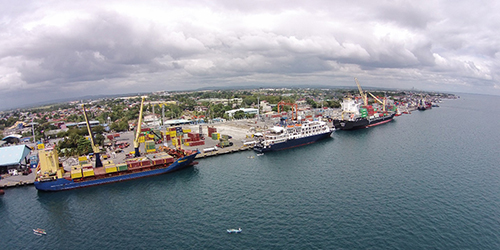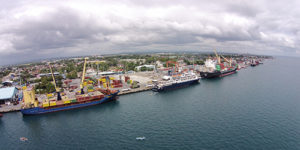

The Philippine Ports Authority (PPA) will continue to modernize ports, especially those in southern Philippines, to heighten their capability to handle cargoes coming from Metro Manila and outside the country, according to PPA acting general manager Atty. Jay Daniel Santiago.
The PPA chief said they are also revisiting development plans for the stalled Davao-Sasa Wharf undertaking.
“We have a lot of port developments ongoing now which will seek to improve the cargo-handling capacity of the port facilities,” Santiago told PortCalls on the sidelines of PPA’s training seminar on September 5.
He said these enhancements include installing quay cranes and other crane facilities meant to better equip outports to handle volumes coming from more modern ports, particularly from Metro Manila.
Particularly targeted for development are ports in Cagayan de Oro, Iloilo, and the Visayas, Santiago said.
The game plan includes making a reliable forecast of cargo traffic growth for each port so that all ports, even the historically underutilized ones, are ready to handle anticipated upsurge, he added.
For private ports, Santiago said PPA will continue to monitor developments as operators of these facilities have committed “under their respective concession agreements.”
Revisiting Davao-Sasa plans
Santiago noted the modernization of Davao-Sasa Wharf is still very much in the pipeline, but that the magnitude and the project cost “will have to be reviewed and reconsidered.”
“As far as I know, it may not be pursued at the rate pursued by the previous administration, (the cost of) which is about P18 billion. Maybe we will have to downscale and re-evaluate the degree of the development,” Santiago said.
The review will ensure the capacity of Davao-Sasa will “be enough and sufficient” for future needs, and that the project cost will be manageable to “address the possible impact in cargo-handling charges.”
Asked if PPA is considering suggestions to develop Davao-Sasa as a domestic and bulk and break bulk terminal instead, Santiago said they are, but noted “we will have to make sure also that any final decisions on the development in the Davao-Sasa Wharf will be able to service the actual needs of the area.”
If studies reveal that the need is primarily for a bulk and break bulk terminal, he said, “then we will pursue that.”
He noted, however, that based on initial studies, “it is advisable that we continue on the current nature of operations which is also to handle international containers.”
The final decision will come from PPA’s mother agency Department of Transportation (DOTr) and from President Rodrigo Duterte, and may be disclosed by the fourth quarter of this year, the PPA chief said.
Bidding out of the P19.8-billion Davao-Sasa port modernization project was rescheduled three times until the new government took over. Transport Secretary Arthur Tugade earlier said they will pursue the project and release their decision by end of the year.
The Davao-Sasa project in its present form is being opposed by the Sangguniang Panlungsod ng Davao, which issued a resolution opposing the bidding, saying no consultation had been held with stakeholders.
Recently, concerned citizens and the Samal City Resorts Owners Association filed a petition with the Supreme Court asking for a writ of kalikasan (nature) and a temporary environmental protection order seeking to stop the bidding off of the project.
The Davao-Sasa port modernization project involves the expansion of the existing port and the construction of dedicated container-handling facilities with a design capacity of approximately 1.2 million twenty-foot equivalent units comprising, among others, the construction of a new apron, linear quay, expansion of back-up area, container yards, warehouses and the installation of new container-handling equipment. The contract also covers operation and maintenance of the port for 30 years.
The petitioners claimed the bidding for the Davao-Sasa project is being conducted “without the necessary Environmental Compliance Certificate and therefore, without the necessary studies on the environmental impacts of the proposed port expansion on the shores of Davao City as well as the famous tourism destinations in the Island Garden of Samal. Even the separate studies of the Philippine Ports Authority and the Department of Transportation and Communications for the modernization and development of the Davao Sasa port do not contain the environmental impact assessment of their respective proposed projects.”
They claimed port operations bring about environmental and noise pollution, increased carbon trail, and serious damage to marine ecosystems in mainland Davao and Samal island.
There was also no consultation with affected communities; the approval of the concerned local government units have not been complied with, they added.
The Davao City Council issued a resolution on 14 December 2015 expressing its objection to the project.
The petitioners likewise questioned the contract price of the project.
They stated that in 2012, the PPA, through Science & Vision for Technology, Inc., conducted a feasibility study on the condition of Sasa Port and its potential new targets in import and export volume increase in the event of an expansion. The report placed at P3.5 billion funds required for the project, including purchase of new equipment and installation of new facilities.
Roro ramp improvement
In line with the modernization plan for the country’s roll-on/roll-off (RoRo) system, Santiago said PPA is working on improving RoRo ramps “to adapt to the inflow of more modern RoRo vessels.”
Maritime Industry Authority administrator Marcial Amaro III had earlier said they plan to modernize the country’s RoRo fleet and phase out ships that are more than 35 years of age. Santiago said PPA has to prepare its ports for the eventual implementation of this plan.
And to complement the ongoing improvement of ports, PPA is conducting port management training for its personnel. Last September 5, some PPA personnel, together with representatives from other port authorities and some terminal operators, participated in a course organized by the United Nations Conference on Trade and Development TrainforTrade program.
Santiago said the joint training with the private sector is important “so that basically the lines of communication and the operational knowledge between the regulator and the operators are in sync” and “so that it will be easier for all parties to align all of their plans and programs and strategic development initiatives.”
“Not only are we trying to equip and upgrade the capacity of our personnel but we are also trying to improve the capacity and the development of our private sector partners,” Santiago said.
Meanwhile, the PPA chief said they are hoping for double-digit growth in cargo volume for 2016. He noted that at Manila ports alone, which account for a big chunk of total shipments, cargo volume had already increased 40% year-on-year as of August.
He added that the increase in volume comes with an average utilization of between 58% and 60%, which Santiago said “basically shows that the operators are able to increase the efficiency of their operations” along with the larger volumes.
Latest official data from PPA showed that volume handled by Port Management Offices of NCR North and South, where Manila ports are under, increased 20% for the first half of 2016 to 20 million metric tons (mmt) from 16.613 mmt in the same period last year. –Roumina Pablo




